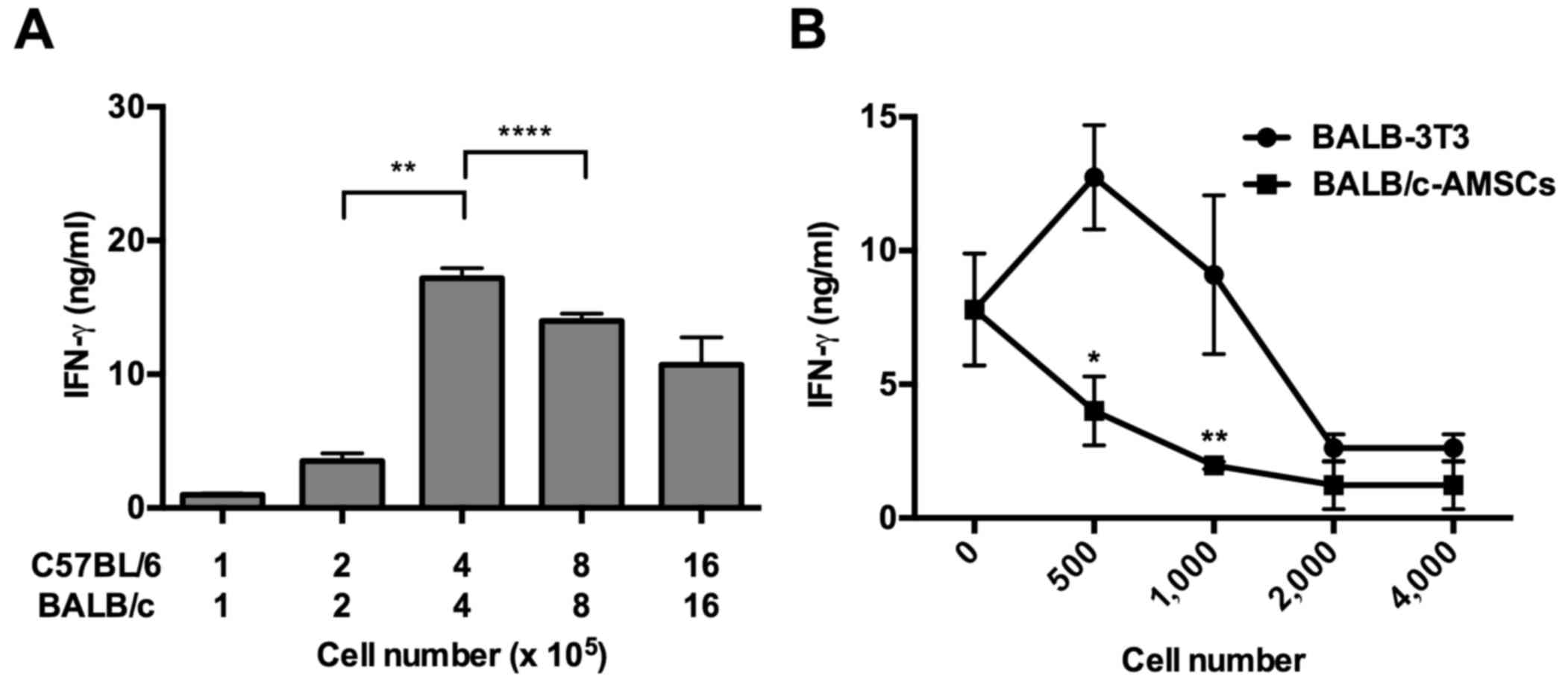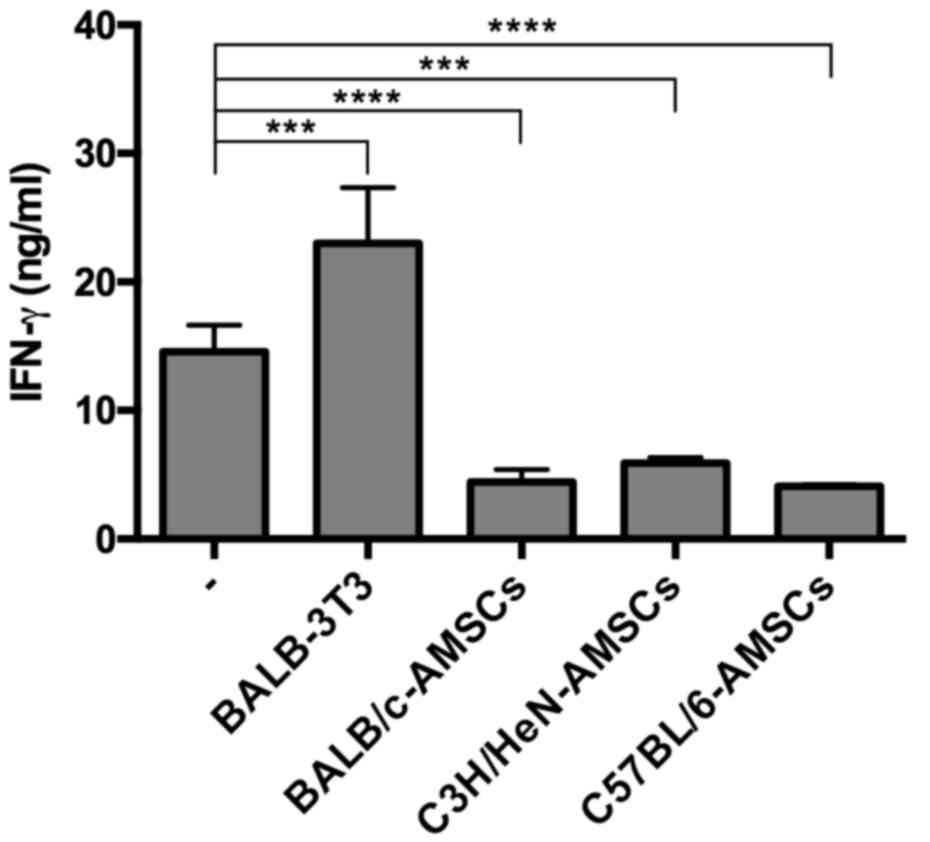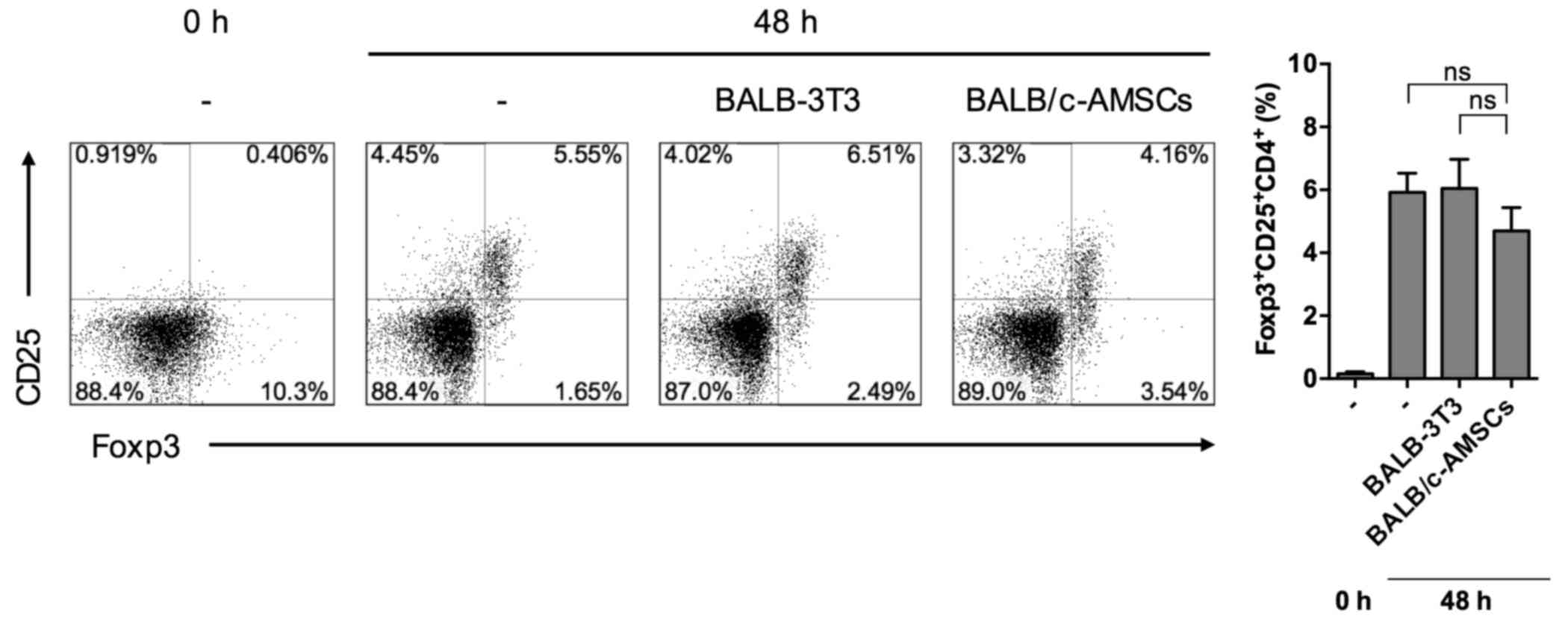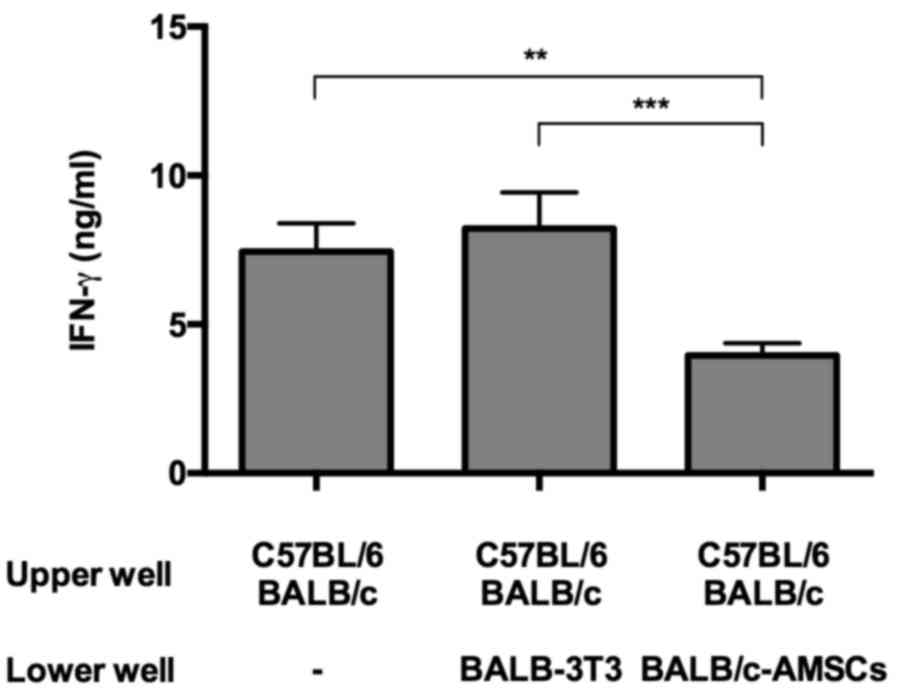Suppression effect on IFN‑γ of adipose tissue‑derived mesenchymal stem cells isolated from β2‑microglobulin‑deficient mice
- Authors:
- Published online on: September 4, 2018 https://doi.org/10.3892/etm.2018.6689
- Pages: 4277-4282
Abstract
Introduction
Mesenchymal stem cells (MSCs) are self-renewable multipotent stromal cells that are capable of differentiation into cells having a mesodermal lineage (1); in addition, in their undifferentiated state they exhibit immunosuppressive properties that can be exploited in the treatment of various inflammatory states. On this basis, MSC administration has the potential to ameliorate inflammation occurring on a wide range of conditions, including heart and brain injury, joint damage, Crohn's disease, multiple sclerosis (2) and acute graft-versus-host disease (GVHD) (3).
The usual source of MSCs is the bone marrow; however, MSCs are also obtainable from adult adipose tissues and whereas MSCs from the latter source [adipose tissue-derived MSCs (AMSCs)] may not be fully identical with bone marrow MSCs, their immunosuppressive properties are thought to be similar or even greater than those of bone marrow MSCs (4,5). Adipose tissue is also quite a useful MSC source since this type of tissue can yield ~500-fold larger (4–6) MSC numbers than those obtainable from bone marrow (7). Additionally, adipose tissue is readily available given the large number of liposuctions performed each year (400,000 in the USA alone), and aspirated adipose tissue obtained in this way is regarded as waste (5,6); thus, no specific tissue donors have to be identified (8).
Acute GVHD is one of the major risks of allogeneic hematopoietic stem cell transplantation therapy in patients suffering from malignant hematopoietic neoplasms and severe bone marrow failure (1). This complication is due to the activation of donor CD8+ T cells by recipient human leucocyte antigen (HLA)-mismatched tissue cells that are thus stimulated to produce a number of pro-inflammatory cytokines, including interferon (IFN)-γ, interleukin (IL)-1β and tumor necrosis factor (TNF)-α (9). This then leads to the various GVHD manifestations, including inflammation of the skin, liver and gastrointestinal tract characterized by rash or erythema, jaundice or diarrhea (10–12). In spite of the fact that MSCs express HLA major histocompatibility complex (MHC) class I molecules that could be recognized by alloreactive T cells mediating GVHD, they appear to escape alloantigen-induced immune destruction following their injection as third party allogeneic cells (13). In addition to the avoidance of alloantigen-induced immune destruction as alluded to above, MSCs exert immunoregulatory properties that lead to the inhibition effector T cells causing the GVHD (14). However, the mechanism of such suppression and whether or not it requires MHC compatibility awaits further investigation (15).
In the present study, an in vitro GVHD model in mice was established, and this model was then used to determine whether AMSCs are able to suppress inflammatory cytokine secretion to the same degree as bone marrow MSCs. In addition, whether MHC class I expression on MSCs is involved in MSC-mediated immunosuppression in GVHD was examined using β2-microglobulin (β2m) knockout mice, which are completely deficient in cell surface expression of MHC class I molecules.
Materials and methods
Animals
A total of 30 male C57BL/6-Ly5.1 mice (age, 6–8 weeks; weight 18–20 g) were obtained from RIKEN BioResource Center (Tsukuba, Japan), and they were maintained in the animal facility at Asahi University (Mizuho, Japan) for 22–24 weeks. A total of 30 male BALB/cCr, 20 male C3H/HeN and 20 male C57BL/6J mice (age, 5 weeks; weight 18–20 g) were purchased from Shimizu Laboratory Supplies (Shizuoka, Japan). A total of 10 male β2m-deficient C57BL/6 (β2m−/−) mice (age, 5 weeks; weight 18–20 g) were purchased from the Jackson Laboratory (Ben Harbor, ME, USA). Animals were maintained at 22–26°C and 50% humidity with a 12-h light/dark cycle and were fed a standardized diet and had ad libitum access to autoclaved tap water. All animal experiments were reviewed and approved by the ethics committee for animal experiments of Asahi University under the ID 12–009.
Monoclonal antibodies (mAbs)
CD4 mAb (cat no. 553047) was purchased from BD Biosciences (San Jose, CA, USA); anti-mouse CD25 mAb (cat no. 12-0251) was obtained from eBioscience, Inc. (San Diego, CA, USA); and anti-mouse forkhead box P3 (Foxp3) mAb (cat no. 20-5773-U100) were from Tonbo Biosciences (San Diego, CA, USA).
Isolation of AMSCs
AMSCs were isolated from various male 6-week-old mice (BALB/cCr, C3H/HeN, C57BL/6 J and β2m−/−) as described previously (16). AMSCs of the third passage were used in the present study.
Mixed lymphocyte reaction (MLR)
Spleen cells were isolated as described previously (17). To decide the optimal cell number of spleen cells for MLR to detect IFN-γ production, spleen cells (1×105−16×105) from recipients (30-week-old male C57BL/6-Ly5.1 mice) were mixed with spleen cells (1×105−16×105) from allogenic donors (30-week-old male BALB/c mice). To decide optimal cell number of AMSCs for the MLR, spleen cells (4×105) from recipients (30-week-old male C57BL/6-Ly5.1 mice) were mixed with spleen cells (4×105) from allogenic donors (30-week-old male BALB/c mice) in the presence or absence of AMSCs (0–4×103) or BALB-3T3 cells (0–4×103). To observe the immunosuppression effect of AMSCs for the MLR, spleen cells (4×105) from recipients (30-week-old male C57BL/6-Ly5.1 mice) were mixed with spleen cells (4×105) from allogenic donors (30-week-old male BALB/c mice) in the presence of AMSCs (1×103) from various mice (BALB/c, C3H/HeN, C57BL/6 and β2m−/−) or BALB-3T3 cells. MLR was performed in 200 µl of RPMI-1640 medium (Sigma-Aldrich; Merck KGaA, Darmstadt, Germany) containing 10% fetal bovine serum (FBS; cat no. F4135; Sigma-Aldrich, Merck KGaA) and 50 µM 2-mercaptoethanol on flat-bottom 96-well plates in 5% CO2 at 37°C for 48 h. The levels of IFN-γ produced in the culture supernatants were determined using mouse IFN-γ ELISA sets (cat no. 555138; BD Biosciences) according to the manufacturer's protocol.
A Transwell assay was performed using a Transwell® insert (polycarbonate membrane with 0.4-µm pore size; Costar; Corning, Inc.; Corning, NY, USA). Spleen cells (8×105) from recipients (30-week-old male C57BL/6-Ly5.1 mice) and spleen cells (8×105) from allogenic donors (30-week-old male BALB/c mice) were cultured on Transwell inserts in the presence or absence of AMSCs (4×103) or BALB-3T3 cells (4×103) in 800 µl of RPMI-1640 medium containing 10% FBS and 50 µM 2-mercaptoethanol on flat-bottom 24-well plates in 5% CO2 at 37°C for 48 h.
Flow cytometric analysis
Following MLR, the cells (8×105) were washed once with ice-cold staining buffer (PBS containing 2% FBS, 1 mM Na2EDTA and 0.1% sodium azide), incubated with anti-CD16/CD32 mAb for 20 min at 4°C and then stained with mAbs against CD4 (fluorescein isothiocyanate; diluted 1:50), CD25 (phycoerythrin; diluted 1:50) for 30 min at 4°C. Following a single wash step with ice-cold staining buffer, the cells were fixed and permeabilized with BD FACS lysis solution and BD FACS permeabilizing solution 2 (both from BD Biosciences) according to the manufacturer's protocol, and then stained with anti-Foxp3 mAb (allophycocyanin; diluted 1:50) for 30 min at room temperature. The viability marker 7-amino actinomycin D (7AAD; cat no. 13-6993-T500; Tonbo Biosciences) was used to eliminate dead cells. Stained cells were analyzed using an Accuri C6 cytometer (BD Biosciences). Data were analyzed using FlowJo software (version 7.6; Tree Star, Inc., Ashland, OR, USA).
Statistical analysis
All quantified results are presented as the mean ± standard deviation. Each experiment was repeated at least 3 times. Statistical analyses were performed using Prism version 6 software (GraphPad Software, Inc., La Jolla, CA, USA). An unpaired t-test or a one-way analysis of variance followed by Dunnett or Tukey-Kramer's post-test analysis were used. P<0.05 was considered to indicate a statistically significant difference.
Results
Morphology, differentiation and immunophenotype characteristics of AMSCs
As previously shown (16), passage-3 AMSCs from 6 week-old BALB/c, C3H/HeN, C57BL/6 and β2m−/− mice all exhibited a similar spindle-shape morphology, ability to differentiate appropriately into adipogenic and osteogenic cells and to express CD44, CD105 and stem cell antigen-1 but not CD45 in flow cytometric analysis regardless of the mouse strain (data not shown) (8).
Suppression of MLR-induced IFN-γ production by AMSCs
To model the capacity of AMSCs to suppress GVHD in vivo, their ability to suppress MLRs in vitro was assessed. First, increasing numbers of whole spleen cells from C57BL/6-Ly5.1 and BALB/c mice were cultured and the culture supernatants were harvested after 48 h to examine whether IFN-γ secretion was generated by MLR. It was observed that a mixture of 4×105 spleen cells exhibited the highest IFN-γ secretion (Fig. 1A). Next, 4×105 whole spleen cells from C57BL/6-Ly5.1 mice were cultured with 4×105 whole spleen cells from BALB/c mice in the presence and absence of BALB/c-AMSCs or BALB-3T3 cells. The addition of increasing numbers of AMSCs to the culture caused increasing suppression of IFN-γ secretion; the addition of a low number of BALB-3T3 cells caused an increase in IFN-γ secretion, whereas the addition of a high number of BALB-3T3 cells suppressed IFN-γ secretion, with the latter being possible due to nutrient depletion and/or cell overgrowth (Fig. 1B). In any case, addition of only 1×103 AMSCs to the culture caused significant suppression of baseline IFN-γ secretion occurring in the absence of AMSCs whereas addition of the same number of BALB-3T3 cells caused no significant suppression of baseline secretion.
Immunosuppression by AMSCs derived from various mouse strains
In further experiments, the capacity of AMSCs derived from various mouse strains to suppress IFN-γ production in the C57BL/6-BALB/c MLR cultures was determined. As before, the addition of 1×103 BALB-3T3 cells to the MLR cultures did not suppress MLR-generated IFN-γ production whereas addition of the same number of AMSCs from BALB/c, C3H/HeN and C57BL/6 mice to the culture all led to significant suppression of IFN-γ (Fig. 2). In related ELISA experiments, it was revealed that IL-1β, TNF, and IL-10 production in the same MRL cultures did not reach detectable levels in the presence or absence of AMSCs (data not shown).
Lack of Foxp3+ Treg cell expansion in MLR cultures containing AMSCs
It was hypothesized that the suppressive effect of AMSC addition may have been due to the induction of Foxp3+ CD25+ CD4+ regulatory T cells (Treg). However, as determined using flow cytometry, the percentage of Tregs among splenocytes in MLR cultures containing BALB/c-AMSCs was equivalent to that in MLR cultures containing BALB/c-3T3 cells (Fig. 3).
Immunosuppression by AMSCs from β2m−/− mice
The suppressive capacity of AMSCs from mice lacking β2m expression was then detected, as such mice do not express MHC class I on the cell surface. However, addition of AMSCs from β2m−/− mice exhibited the ability to suppress IFN-γ secretion. In addition, the level of suppression obtained with wild-type (WT) and β2m−/− AMSCs was equivalent, with no significant difference (Fig. 4).
Suppression of IFN-γ secretion by AMSC secretions
Finally, to determine if the suppressive function exerted by AMSCs required cell contact in the MLR cultures, AMSCs and MLR cells were cultured separately in the upper and lower Transwell compartments, respectively. Under these conditions AMSCs but not 3T3 cells significantly suppressed IFN-γ secretion, indicating that AMSC suppression is mediated by a soluble factor, at least partly (Fig. 5).
Discussion
MSCs are a highly heterogeneous population of cells whose precise phenotype culture remains debated (18). Despite this heterogeneity, it was established in the present study that AMSCs harvested from adipose tissue obtained from three different mouse strains were morphologically and phenotypically identical and had an equal capacity to suppress IFN-γ production generated in MLR cultures serving as an in vitro model of GVHD. In addition, it was revealed that such suppression was also observed with AMSCs obtained from mice deficient in β2m, an MHC class I subunit that is required for cell surface MHC class I molecule expression. These observations indicate that MHC class I expression on the AMSCs is dispensable for AMSC suppressor activity. Notably, in a previous study it was revealed that downregulation of β2m by exposure of AMSC-containing cultures to β2m-specific small interfering RNA led to a modest reduction in AMSC suppression (16). However, in showing that AMSCs from mice that are genetically deficient in β2m have an equal ability to mediate suppression as compared with WT cells, the present study is more definitive in showing that cell-cell contact involving MHC class I is not, in fact, involved in AMSC immunosuppression.
IFN-γ is the major type 1 T helper (Th1)-inducing or associated cytokine responsible for the inflammatory state caused by acute GVHD (19). Splenocytes of aged mice produce more IFN-γ than splenocytes of young mice since the spleens of aged mice contain markedly increased numbers of CD8+ CD122+ T cells (20). The AMSC suppressor activity was therefore assessed in MLR cultures containing splenocytes from 30-week-old BALB/c and C57BL/6-Ly5.1 mice in the present study, and robust IFN-γ production was thereby obtained in the MLR cultures, albeit less than that obtained in anti-CD3ε/anti-CD28-stimulated cultures (16,20). The data of the present study revealed that despite this robust Th1-inducing MLR response, addition of only 1×103 AMSCs suppressed IFN-γ production in the MLR. These results indicate that AMSCs have an immunosuppressive capacity equal to that of bone marrow derived MSCs (8).
One possible mechanism of AMSC suppression in the absence of AMSCs MHC class I expression is that AMSCs secrete HLA-G, a non-classical MHC class I molecule with suppressor function that was originally thought to explain the ability of cells in human trophoblasts to evade maternal immunorejection (21). HLA-G secreted by human bone marrow MSCs has also been reported to serve a pivotal role in the ability of human MSCs to suppress proliferation of cells in allogeneic MLR cultures (21,22). Murine Qa-2 is considered to be the functional homolog of human HLA-G and has been demonstrated to be involved in natural killer cell-mediated suppression of CD4+ T cell responses (23). Since an alternative (soluble) form of HLA-G can be secreted in the absence of β2m (24,25), it is possible that a similar form of Qa-2 secreted by β2m−/− murine AMSCs may account for AMSC regulatory function in mice (26,27).
Exosomes budding from the plasma membrane are known to contain immune modulators, including HLA-G, IL-10 and transforming growth factor-β (28,29). Thus, while the MLR supernatants in the present study contained little if any IL-10, the immunosuppression mediated by these MLR supernatants may have been due to immune modulators associated with exosomes.
In summary, the observations reported in the present study indicate that AMSCs are cells with potent suppressor activity for the allogeneic interactions that accompany GVHD and that such suppressor activity does not require MHC complementarity. Thus, AMSCs may serve as a useful source for the control of GVHD in humans.
Acknowledgements
The present study was supported in part by the Grants-in-Aid for Scientific Research from the Japan Society for the Promotion of Science (grant nos. 24592851 and 15K11096), Program to Disseminate Tenure Tracking System, The Ministry of Education, Culture, Sports, Science and Technology (MEXT), Japan, Okayama Foundation for Science and Technology, Ryobi Teien Memory Foundation and Sanyo Hohso Foundation.
References
|
Abdi R, Fiorina P, Adra CN, Atkinson M and Sayegh MH: Immunomodulation by mesenchymal stem cells: A potential therapeutic strategy for type 1 diabetes. Diabetes. 57:1759–1767. 2008. View Article : Google Scholar : PubMed/NCBI | |
|
Shen H: Stricter standards sought to curb stem-cell confusion. Nature. 499:3892013. View Article : Google Scholar : PubMed/NCBI | |
|
Miura Y, Yoshioka S, Yao H, Takaori-Kondo A, Maekawa T and Ichinohe T: Chimerism of bone marrow mesenchymal stem/stromal cells in allogeneic hematopoietic cell transplantation: Is it clinically relevant? Chimerism. 4:78–83. 2013. View Article : Google Scholar : PubMed/NCBI | |
|
Fraser JK, Wulur I, Alfonso Z and Hedrick MH: Fat tissue: An underappreciated source of stem cells for biotechnology. Trends Biotechnol. 24:150–154. 2006. View Article : Google Scholar : PubMed/NCBI | |
|
Melief SM, Zwaginga JJ, Fibbe WE and Roelofs H: Adipose tissue-derived multipotent stromal cells have a higher immunomodulatory capacity than their bone marrow-derived counterparts. Stem Cells Transl Med. 2:455–463. 2013. View Article : Google Scholar : PubMed/NCBI | |
|
Gimble JM, Katz AJ and Bunnell BA: Adipose-derived stem cells for regenerative medicine. Circ Res. 100:1249–1260. 2007. View Article : Google Scholar : PubMed/NCBI | |
|
Ning H, Yang F, Jiang M, Hu L, Feng K, Zhang J, Yu Z, Li B, Xu C, Li Y, et al: The correlation between cotransplantation of mesenchymal stem cells and higher recurrence rate in hematologic malignancy patients: Outcome of a pilot clinical study. Leukemia. 22:593–599. 2008. View Article : Google Scholar : PubMed/NCBI | |
|
Yañez R, Lamana ML, García-Castro J, Colmenero I, Ramírez M and Bueren JA: Adipose tissue-derived mesenchymal stem cells have in vivo immunosuppressive properties applicable for the control of the graft-versus-host disease. Stem Cells. 24:2582–2591. 2006. View Article : Google Scholar : PubMed/NCBI | |
|
Liang Y, Ma S, Zhang Y, Wang Y, Cheng Q, Wu Y, Jin Y, Zheng D, Wu D and Liu H: IL-1β and TLR4 signaling are involved in the aggravated murine acute graft-versus-host disease caused by delayed bortezomib administration. J Immunol. 192:1277–1285. 2014. View Article : Google Scholar : PubMed/NCBI | |
|
McDonald GB, Shulman HM, Sullivan KM and Spencer GD: Intestinal and hepatic complications of human bone marrow transplantation. Part I. Gastroenterology. 90:460–477. 1986. View Article : Google Scholar : PubMed/NCBI | |
|
Deeg HJ and Antin JH: The clinical spectrum of acute graft-versus-host disease. Semin Hematol. 43:24–31. 2006. View Article : Google Scholar : PubMed/NCBI | |
|
McDonald GB: Hepatobiliary complications of hematopoietic cell transplantation, 40 years on. Hepatology. 51:1450–1460. 2010. View Article : Google Scholar : PubMed/NCBI | |
|
Tse WT, Pendleton JD, Beyer WM, Egalka MC and Guinan EC: Suppression of allogeneic T-cell proliferation by human marrow stromal cells: Implications in transplantation. Transplantation. 75:389–397. 2003. View Article : Google Scholar : PubMed/NCBI | |
|
Le Blanc K, Rasmusson I, Sundberg B, Götherström C, Hassan M, Uzunel M and Ringdén O: Treatment of severe acute graft-versus-host disease with third party haploidentical mesenchymal stem cells. Lancet. 363:1439–1441. 2004. View Article : Google Scholar : PubMed/NCBI | |
|
Choi SW and Reddy P: Current and emerging strategies for the prevention of graft-versus-host disease. Nat Rev Clin Oncol. 11:536–547. 2014. View Article : Google Scholar : PubMed/NCBI | |
|
Nagaya R, Mizuno-Kamiya M, Takayama E, Kawaki H, Onoe I, Tanabe T, Nagahara K and Kondoh N: Mechanisms of the immunosuppressive effects of mouse adipose tissue-derived mesenchymal stromal cells on mouse alloreactively stimulated spleen cells. Exp Ther Med. 7:17–22. 2014. View Article : Google Scholar : PubMed/NCBI | |
|
Masuda J, Takayama E, Strober W, Satoh A, Morimoto Y, Honjo Y, Ichinohe T, Tokuno SI, Ishizuka T, Nakata T, et al: Tumor growth limited to subcutaneous site vs tumor growth in pulmonary site exhibit differential effects on systemic immunities. Oncol Rep. 38:449–455. 2017. View Article : Google Scholar : PubMed/NCBI | |
|
Yu J, Du W, Yan F, Wang Y, Li H, Cao S, Yu W, Shen C, Liu J and Ren X: Myeloid-derived suppressor cells suppress antitumor immune responses through IDO expression and correlate with lymph node metastasis in patients with breast cancer. J Immunol. 190:3783–3797. 2013. View Article : Google Scholar : PubMed/NCBI | |
|
Lim JY, Park MJ, Im KI, Kim N, Jeon EJ, Kim EJ, Cho ML and Cho SG: Combination cell therapy using mesenchymal stem cells and regulatory T-cells provides a synergistic immunomodulatory effect associated with reciprocal regulation of TH1/TH2 and th17/treg cells in a murine acute graft-versus-host disease model. Cell Transplant. 23:703–714. 2014. View Article : Google Scholar : PubMed/NCBI | |
|
Takayama E, Seki S, Ohkawa T, Ami K, Habu Y, Yamaguchi T, Tadakuma T and Hiraide H: Mouse CD8+ CD122+ T cells with intermediate TCR increasing with age provide a source of early IFN-gamma production. J Immunol. 164:5652–5658. 2000. View Article : Google Scholar : PubMed/NCBI | |
|
Favier B, LeMaoult J and Carosella ED: Functions of HLA-G in the immune system. Tissue Antigens. 69 Suppl 1:S150–S152. 2007. View Article : Google Scholar | |
|
Nasef A, Mathieu N, Chapel A, Frick J, François S, Mazurier C, Boutarfa A, Bouchet S, Gorin NC, Thierry D and Fouillard L: Immunosuppressive effects of mesenchymal stem cells: Involvement of HLA-G. Transplantation. 84:231–237. 2007. View Article : Google Scholar : PubMed/NCBI | |
|
Melo-Lima BL, Evangelista AF, de Magalhães DA, Passos GA, Moreau P and Donadi EA: Differential transcript profiles of MHC class Ib(Qa-1, Qa-2, and Qa-10) and Aire genes during the ontogeny of thymus and other tissues. J Immunol Res. 2014:1592472014. View Article : Google Scholar : PubMed/NCBI | |
|
Shiroishi M, Kuroki K, Rasubala L, Tsumoto K, Kumagai I, Kurimoto E, Kato K, Kohda D and Maenaka K: Structural basis for recognition of the nonclassical MHC molecule HLA-G by the leukocyte Ig-like receptor B2 (LILRB2/LIR2/ILT4/CD85d). Proc Natl Acad Sci USA. 103:16412–16417. 2006. View Article : Google Scholar : PubMed/NCBI | |
|
Carosella ED, Gregori S and LeMaoult J: The tolerogenic interplay(s) among HLA-G, myeloid APCs, and regulatory cells. Blood. 118:6499–6505. 2011. View Article : Google Scholar : PubMed/NCBI | |
|
Ulker N, Lewis KD, Hood LE and Stroynowski I: Activated T cells transcribe an alternatively spliced mRNA encoding a soluble form of Qa-2 antigen. EMBO J. 9:3839–3847. 1990. View Article : Google Scholar : PubMed/NCBI | |
|
Comiskey M, Goldstein CY, De Fazio SR, Mammolenti M, Newmark JA and Warner CM: Evidence that HLA-G is the functional homolog of mouse Qa-2, the Ped gene product. Hum Immunol. 64:999–1004. 2003. View Article : Google Scholar : PubMed/NCBI | |
|
Ludwig AK and Giebel B: Exosomes: Small vesicles participating in intercellular communication. Int J Biochem Cell Biol. 44:11–15. 2012. View Article : Google Scholar : PubMed/NCBI | |
|
Alegre E, Rebmann V, Lemaoult J, Rodriguez C, Horn PA, Díaz-Lagares A, Echeveste JI and González A: In vivo identification of an HLA-G complex as ubiquitinated protein circulating in exosomes. Eur J Immunol. 43:1933–1991. 2013. View Article : Google Scholar : PubMed/NCBI |














